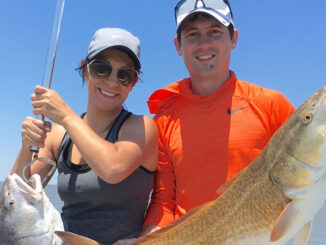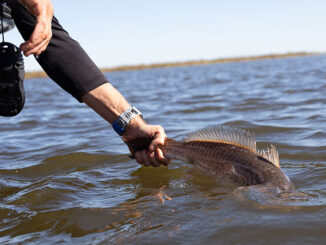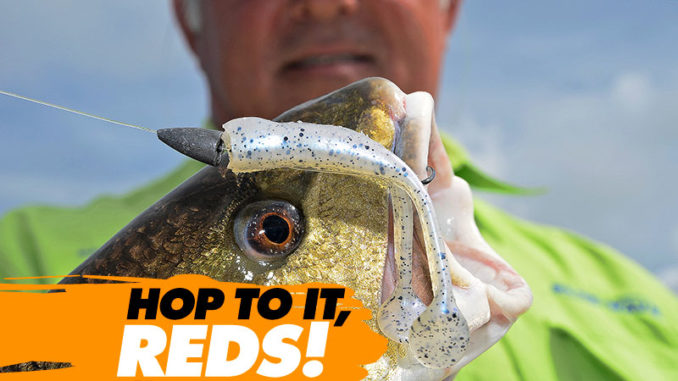
Soft-plastic frogs, a staple among freshwater bass fishermen, can put a hurting on redfish, too. Here are some places to fish them, and how.
Hunkered down in thick cover, a large, pot-bellied fish tracked the silhouette of a frog flitting across matted grass just two feet above its head, waiting for an opportune time to strike its prey.
The creature briefly rested atop the grass and then slid into a tiny pocket of open water. It remained momentarily motionless before slowly sinking. Quivering as it descended, it regained its composure and climbed over another grass clump.
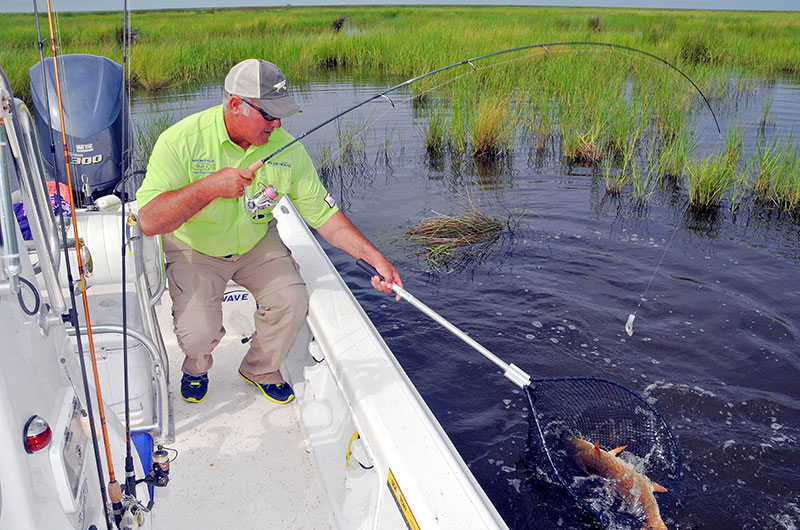
The hungry predator could stand it no longer. The fish opened its mouth and lunged. As if a dynamite charge exploded beneath the surface, water erupted and spewed frothy weeds across the shallow flat. The enraged beast gulped the frog and a chunk of vegetation in the process. However, instead of slurping a succulent frog steak, the surprised redfish sucked down a mouthful of plastic, imbedded with hooks.
Redfish live in brackish to saltwater. Frogs normally prefer sweeter environments. The two species rarely meet in nature. Although spot-tailed marsh marauders seldom intentionally pursue live frogs, a hungry redfish won’t pass up a potential meal.
“Frogs are not on the everyday menu for redfish, but a redfish will eat just about anything,” said Mike Gallo of Angling Adventures of Louisiana, who fishes the marshes surrounding Lake Borgne. “If a redfish sees a frog and gets a chance to eat it, it will. Redfish don’t necessarily know what it is. They just think it’s something to eat. If something fits into its mouth, a redfish will eat it.”
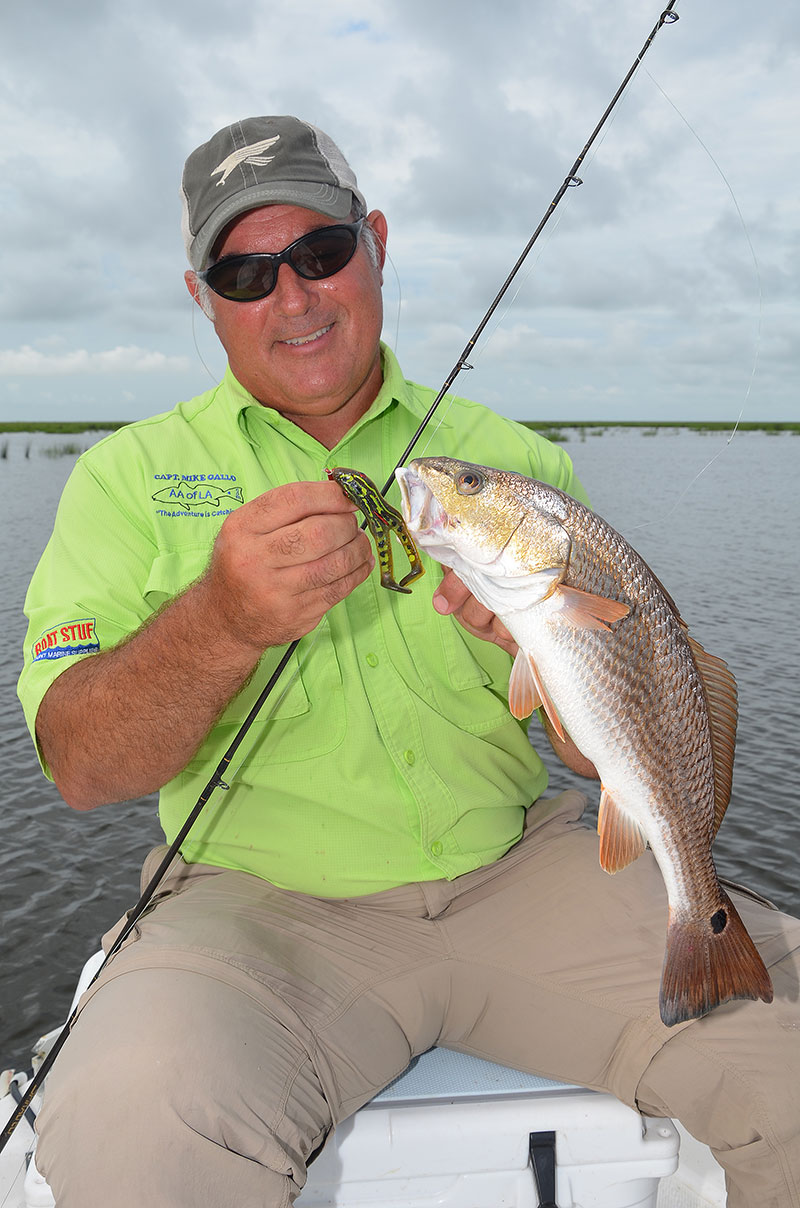
Bass, redfish similarities
Soft-plastic frogs look and feel like natural prey. In brackish waters, like the deltas of the Pearl, Sabine or Mississippi rivers, anglers might catch largemouth bass and redfish in the same areas, using the same frog. Like largemouths, redfish commonly ambush prey rather than running it down in open water like speckled trout. Also like bass, redfish regularly seek the thickest cover they can find along marshy shorelines. Few other baits can go over matted vegetation like a soft-plastic frog.
“One time, I watched a redfish hide in the grass as a frog approached it,” Gallo said. “As the frog steadily came toward it, I could see the redfish lower itself in the water so it could tilt its head upward and look behind him, because it could hear the lure coming. A Stanley Ribbit frog puts off great vibrations. The redfish waited for the frog to pass over it and then attacked it from behind.”
Some plastic frogs float, and others slowly sink. Some floating frogs come with upturned hooks so they can easily slip over the thickest grass mats. Rig slow-sinking frogs with a hook inserted into the soft-plastic body to make it weedless.
Some floating frogs look like traditional topwater poppers with blunt or concave noses. Fish these baits the same way as a hard surface plug, but over the most-entangling cover. Cast it to a likely spot and let it sit a few moments or just twitch it a bit. Then, vigorously pop the frog so it jumps a foot or two and let it sit again. This simulates a live frog splashing on the surface. Sometimes, redfish blow up on these baits with incredibly vicious strikes.
Other lures look more like live frogs with kicking legs. Buzz these baits across the surface with a steady retrieve, an excellent tactic when targeting aggressive fish. Hold the rod tip high to keep the lure on the surface with the legs churning up a commotion.
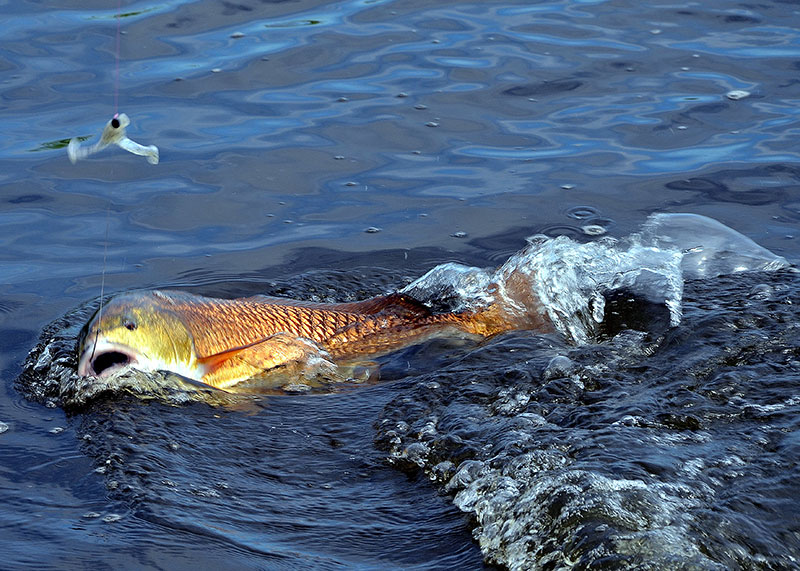
Froggy went a courtin’
A steady, surface-buzzing retrieve not only elicits powerful strikes, but it creates a great way to search for redfish. Even if fish don’t strike the bait, they might reveal their locations. If so, follow up with more subtle offerings like a weightless soft-plastic fluke or similar bait.
In scattered, weedy cover, pull a frog across the surface in short, quick hops like a live frog. Occasionally, let it sit on the surface or a grass clump for a while. When the frog rests atop matted grass, fish can still see the lifelike silhouette against the bright sky and line up for a devastating strike.
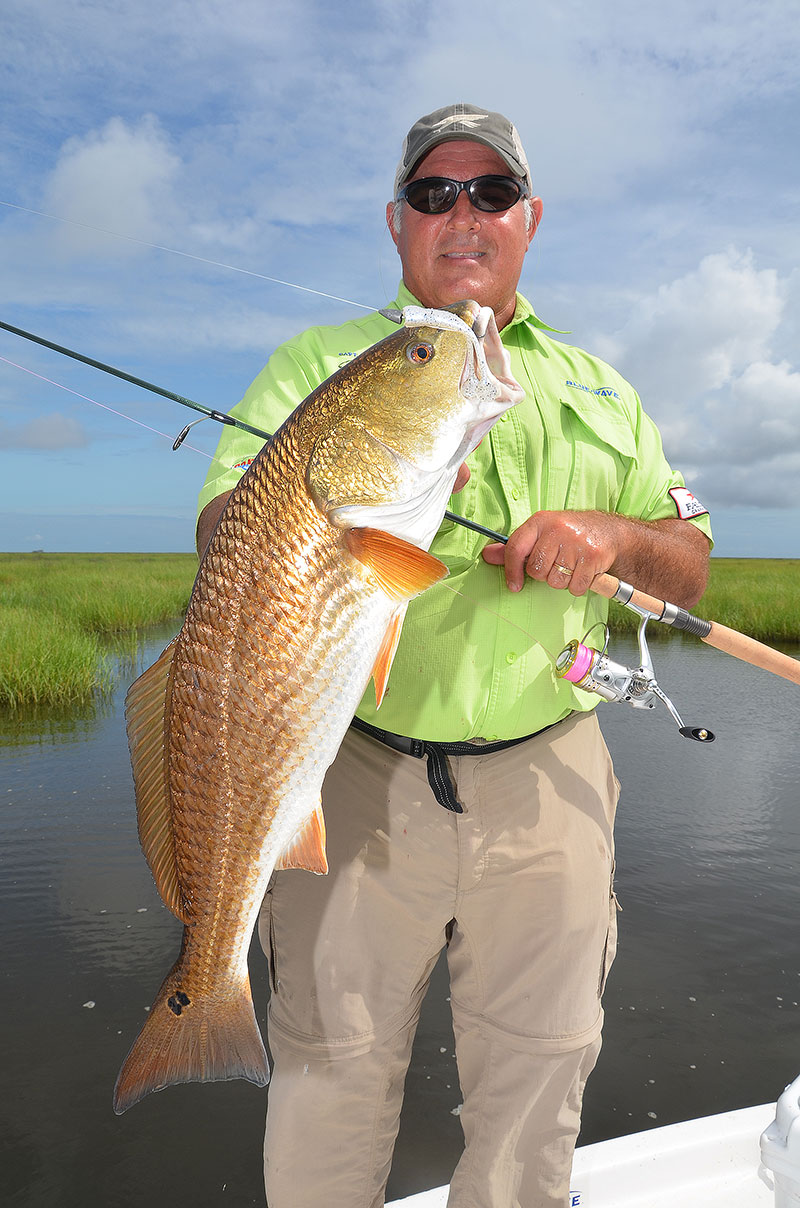
In the thickest weeds, “crawl” a sinking frog over grassy mats. At the edge of an open pocket, pause a few seconds. Then, pull the frog over the edge so it plops into the open water and starts to sink. Like bass, redfish sometimes follow prey in cover, waiting for a chance to strike. Spotting prey slithering into the water could prove too irresistible for a hungry redfish.
A sinking frog also works when fished around submerged vegetation. Cast it beyond the cover and pull it steadily toward the grass bed. Periodically pause to let it sink down to the grass tops. As the frog slowly sinks, its appendages quiver, driving redfish nuts. Big reds habitually slurp frogs as they fall. If not, pull the lure back to the surface and continue the retrieve.
“I really enjoy the versatility of frogs,” Gallo said. “I can run a frog across the surface like a topwater bait or let it sink to the bottom. I’ve even fished frogs under popping corks in the grass when the water is high. Since it’s weedless, it’s the perfect bait to use in thick grass. That’s where the bait hides.”
Don’t weigh me down
Whenever possible, try to throw a frog with no weight. On windy days, stiff breezes can rip across the treeless Louisiana marshes, making casting difficult. If necessary, add a split-shot or two to the line above the frog. Anglers can also rig frogs with keel-weighted hooks to add extra casting heft. Weighted frogs typically work best in open water or places with submerged vegetation where anglers need to make long casts.
Frogs can attract redfish anywhere, but they work especially well in lush, brackish marshes with abundant plant growth, such as around the freshwater diversions in places like Caernarvon, the Lake Salvador area or river deltas. The copious influx of freshwater promotes vegetation growth. Besides grass, anglers can also fish frogs around oyster reefs, fallen trees, flats, dock pilings, jetties — places redfish hide to waylay bait. In some places, anglers can cast frogs over obstructions to fish rarely touched in deeper pockets behind them.
Biloxi Marsh madness
Gallo frequently fishes the Biloxi Marsh along the southern shoreline of Lake Borgne. Reachable only by boat makes the remote area less pressured than more-accessible areas. Gallo often crosses Lake Borgne from his lodge in Slidell. Others can launch at Shell Beach or Hopedale in St. Bernard Parish. Some people run across open water from Waveland, Miss., to fish what they call “the Louisiana Marsh.” Although due south of the Mississippi coast, the entire area sits in Louisiana.
“The Biloxi Marsh is a special place, with some of the best redfish habitat in the nation,” Gallo said. “The fishing is a lot more consistent than some other areas. Because it’s so remote and inaccessible, I don’t see a lot of boats in the marshes. Even on a major holiday like the fourth of July, I might only see 15 to 20 boats. When I go out fishing during the week, I usually don’t see anyone. I might see crabbers working or shrimpers dragging their nets, but I typically don’t see many other recreational anglers.”
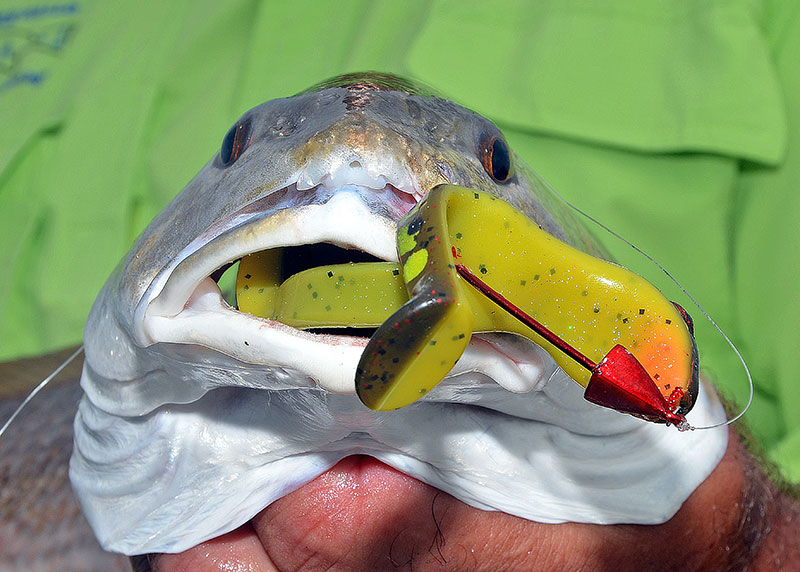
Also called the Bayou Biloxi Marsh, the area juts eastward between Lake Borgne and Chandeleur Sound. These wetlands spread across about 600 square miles of marshy bayous, shallow ponds and canals. The Biloxi Wildlife Management Area, a fabled duck hunting spot, reserves 35,644 acres of the marshland. Several grassy islands dominate the extreme eastern edge of the area along Chandeleur Sound. Anglers commonly catch giant bull reds around the islands in deeper water at the edge of the mainland marsh,
Plastic frogs can work whenever redfish might hit topwater baits, or at any time except the coldest months. As winter approaches, reds gorge themselves to prepare for the coming scarce times, so they hit more aggressively before seriously cold weather hits. Some better places to fish in the Biloxi Marsh include the mouths of any bayous feeding into Lake Borgne, but just about any shoreline in that vast area could produce good redfish action.
“The grass starts to die out in late summer and into the fall and winter and grows back in the spring,” Gallo said. “The areas where the grass dies out last in the fall are the areas that grow back first in the spring. Those main bayous all have a lot of duck ponds near them. All the duck ponds are redfish havens. Redfish like those shallow ponds where they can root around on the bottom looking for crabs, shrimp and mussels to eat.”
Although seldom the first choice for redfish, plastic frogs can put more spot-tails into the boat under the right circumstances. When fishing nearly impenetrable grass canopies, catch the buzz and tempt reds where others can’t even fish.
For more information about Mike Gallo of Angling Adventures of Louisiana, call 877-4AAOFLA or visit www.aaofla.com.

